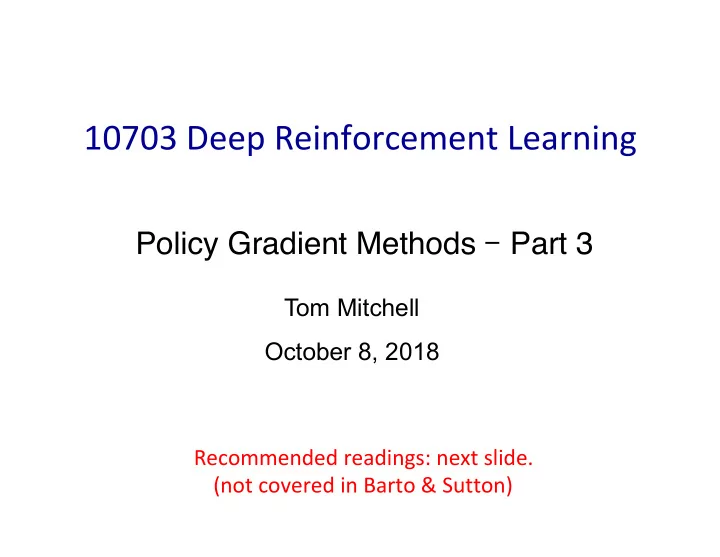

10703 Deep Reinforcement Learning Policy Gradient Methods – Part 3 Tom Mitchell October 8, 2018 Recommended readings: next slide. (not covered in Barto & Sutton)
Used Materials • Disclaimer : Much of the material and slides for this lecture were borrowed from Ruslan Salakhutdinov, who in turn borrowed from Rich Sutton’s RL class and David Silver’s Deep RL tutorial
Recommended Readings on Natural Policy Gradient and Convergence of Actor-Critic Learning
Actor-Critic ‣ Monte-Carlo policy gradient still has high variance ‣ We can use a critic to estimate the action-value function: ‣ Actor-critic algorithms maintain two sets of parameters - Critic Updates action-value function parameters w - Actor Updates policy parameters θ , in direction suggested by critic ‣ Actor-critic algorithms follow an approximate policy gradient
Reducing Variance Using a Baseline ‣ We can subtract a baseline function B(s) from the policy gradient ‣ This can reduce variance, without changing expectation! ‣ A good baseline is the state value function ‣ So we can rewrite the policy gradient using the advantage function: ‣ Note that it is the exact same policy gradient:
Estimating the Advantage Function ‣ For the true value function , the TD error: is an unbiased estimate of the advantage function: ‣ So we can use the TD error to compute the policy gradient ‣ Remember the policy gradient
Estimating the Advantage Function ‣ For the true value function , the TD error: is an unbiased estimate of the advantage function ‣ So we can use the TD error to compute the policy gradient ‣ In practice we can use an approximate TD error ‣ This approach only requires one set of critic parameters v
Dueling Networks ‣ Split Q-network into two channels ‣ Action-independent value function V(s,v) ‣ Action-dependent advantage function A(s, a, w) ‣ Advantage function is defined as: Wang et.al., ICML, 2016
Advantage Actor-Critic Algorithm
So Far: Summary of PG Algorithms ‣ The policy gradient has many equivalent forms ‣ Each leads a stochastic gradient ascent algorithm ‣ Critic uses policy evaluation (e.g. MC or TD learning) to estimate
But will it converge if we use function approximation?? Under what conditions??
Bias in Actor-Critic Algorithms ‣ Approximating the policy gradient introduces bias ‣ A biased policy gradient may not find the right solution ‣ Luckily, if we choose value function approximation carefully ‣ Then we can avoid introducing any bias ‣ i.e. we can still follow the exact policy gradient
Compatible Function Approximation ‣ If the following two conditions are satisfied: 1. Value function approximator is compatible with the policy 2 Value function parameters w minimize the mean-squared error ‣ Then the policy gradient is exact, ‣ Remember:
Proof ‣ If w is chosen to minimize mean-squared error ε , then gradient of ε with respect to w must be zero, ‣ So Q w (s, a) can be substituted directly into the policy gradient, ‣ Remember:
Proof ‣ If w is chosen to minimize mean-squared error ε , note error ε need not then gradient of ε with respect to w must be zero, be zero, just needs to be minimized! note we only need to within a constant! ‣ So Q w (s, a) can be substituted directly into the policy gradient, ‣ Remember:
Compatible Function Approximation ‣ If the following two conditions are satisfied: 1. Value function approximator is compatible with the policy How can we achieve this?? 2 Value function parameters w minimize the mean-squared error ‣ Then the policy gradient is exact, ‣ Remember:
Compatible Function Approximation ‣ If the following two conditions are satisfied: 1. Value function approximator is compatible with the policy How can we achieve this?? One way: make Q w and π θ both be linear functions of same features of s,a ‣ let Φ (s,a) be a vector of features describing the pair (s,a) ‣ let Q w (s,a) = w T Φ (s,a) . let log π θ (s,a) = θ T Φ (s,a) ‣ then
Compatible Function Approximation How can we achieve this?? One way: make Q w and π θ both be linear functions of same features of s,a ‣ let Φ (s,a) be a vector of features describing the pair (s,a) ‣ let Q w (s,a) = w T Φ (s,a) . let log π θ (s,a) = θ T Φ (s,a) ‣ then Q w (s,a) = w a T Φ (s) log π θ (s,a) = θ a T Φ (s) Φ (s)
Alternative Policy Gradient Directions ‣ Generalized gradient ascent algorithms can follow any ascent direction ‣ A good ascent direction can significantly speed convergence ‣ Also, a policy can often be reparametrized without changing action probabilities ‣ For example, increasing score of all actions in a softmax policy ‣ The vanilla gradient is sensitive to these reparametrizations ‣ but the natural gradient is not!
Natural Policy Gradient ‣ The natural policy gradient is parameterization independent (i.e., not influenced by set of parameters you use to define ‣ it finds ascent direction that is closest to vanilla gradient ‣ where G θ is the Fisher information matrix
Natural Policy Gradient ‣ The natural policy gradient is parameterization independent (i.e., not influenced by set of parameters you use to define ‣ where G θ is the Fisher information matrix ‣ what is the <i, j>th element of G θ ? ‣ what is G θ if we have a parameterization that yields the natural gradient?
Under linear model: Natural Actor-Critic ‣ Using compatible function approximation, ‣ The natural policy gradient simplifies, ‣ i.e. update actor parameters in direction of critic parameters!
from: Peters and Schaal
from: Kakade
Summary of Policy Gradient Algorithms ‣ The policy gradient has many equivalent forms ‣ Each leads a stochastic gradient ascent algorithm ‣ Critic uses policy evaluation (e.g. MC or TD learning) to estimate
Recommend
More recommend